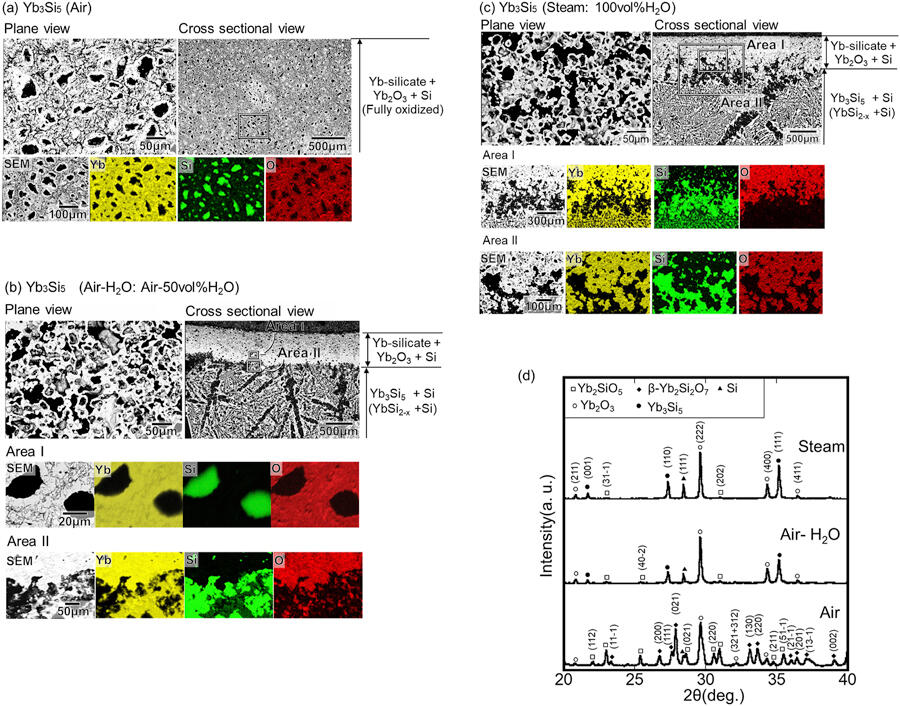2020.12.09 Wednesday
Beating the Heat: Oxidation in Novel Coating Material for Aircraft Gas Turbine Engines
Scientists investigate oxidative reactions in ytterbium silicide, a heat-resistant coating, to improve heat efficiency in aircraft gas turbine engines
Ytterbium silicide (Yb-Si) is a promising coating material for the high-temperature sections of aircraft gas turbine engines. Although Yb-Si is heat-resistant and prevents formation of structurally harmful SiO2 in the coating, its oxidation mechanisms are unclear. In a recent study, scientists from Japan demonstrate how the Yb to Si ratio in the material, and the surrounding atmosphere, affect the oxidation processes in Yb-Si, opening doors to more energy efficient gas turbines.
Certain sections of aero gas-turbine engines, which are widely used in aircrafts, regularly reach temperatures above 1,200 °C. Needless to say, any materials used in such harsh environments must be durable and up to the task. Ceramic matrix composites made of silicon carbide (SiC) have recently garnered interest as promising candidates for gas-turbine engines. However, these materials require a heat-resistant coating layer to prevent the oxidation of SiC and subsequent evaporation of SiO2, which is a process that leads to a decrease in the material volume and, therefore, structural defects such as large cracks or the topmost layer flaking off.
Unfortunately, existing coating layers cannot fully prevent this oxidization to SiO2 because oxygen can permeate through microscopic cracks in these layers or by simple diffusion.
To address this issue, some scientists have focused on using ytterbium silicide (Yb-Si) as a coating material because Yb-Si can reach high melting points and their oxides are mainly Yb-silicates, which remain attached as an oxide layer and do not evaporate easily. However, not much is known about the fundamental phenomena that take place in these materials at high temperatures in either air or water vapor environments.
In a recent study published in Intermetallics, a team of scientists-including Junior Associate Professor Ryo Inoue, Assistant Professor Yutaro Arai and Professor Yasuo Kogo from Tokyo University of Science, and Senior Researcher Takuya Aoki from the Japan Aerospace Exploration Agency (JAXA)-set out to understand the oxidation mechanisms in Yb-Si. They conducted a variety of experiments to gain insight into the oxidation behavior (and degradation) of different Yb-Si coatings at high temperatures under three types of atmospheres: air, water vapor, and a mixture of both.
Through X-ray diffraction analysis, energy dispersive spectroscopy, and scanning electron microscopy, the scientists were able to accurately visualize and quantify the morphology and composition of the Yb-Si samples before and after the heat exposure tests. One of the main findings was that the Yb to Si ratio was a major player in defining the oxidation behavior of the material; Yb5Si
Most importantly, the researchers explored the mechanisms by which ytterbium content can affect the formation of SiO2. "After heat exposure of both silicides in steam, we found SiO2 in Yb5Si3, whereas Si was actually still present in Yb3Si5," remarks Dr Inoue, who led the study. "Our analyses indicate that SiO2 growth is suppressed in Yb3Si5 because SiO2 partakes in, and is the limiting factor of, reactions that form Yb-silicates," he adds. Though the exact intermediate reactions that lead to the formation of the various Yb-silicates are not completely understood yet, the team presented two highly possible reaction pathways. This will likely be clarified through future studies with even more detailed characterization techniques.
 |
by scanning electron microscopy images and X-ray diffraciton peaks
Photo courtesy: Ryo Inoue from Tokyo University of Science
Overall, this study provides meaningful insight into what happens during the oxidation of Yb-Si, which will help in the development of protective coatings for aero gas-turbine engines. "If a coating that can withstand harsher environments can be realized, engine parts will become more heat resistant, which naturally leads to higher engine efficiency," remarks Dr Inoue.
Hopefully, further advances in coating technology will reduce aerial transportation costs and fuel consumption, making flying cheaper and less harmful to the environment.
Reference
| Title of original paper | : | Oxidation behavior of ytterbium silicide in air and steam |
| Journal | : | Intermetallics |
| DOI | : | 10.1016/j.intermet.2020.106992 |
About The Tokyo University of Science

Tokyo University of Science (TUS) is a well-known and respected university, and the largest science-specialized private research university in Japan, with four campuses in central Tokyo and its suburbs and in Hokkaido. Established in 1881, the university has continually contributed to Japan's development in science through inculcating the love for science in researchers, technicians, and educators.
With a mission of "Creating science and technology for the harmonious development of nature, human beings, and society", TUS has undertaken a wide range of research from basic to applied science. TUS has embraced a multidisciplinary approach to research and undertaken intensive study in some of today's most vital fields. TUS is a meritocracy where the best in science is recognized and nurtured. It is the only private university in Japan that has produced a Nobel Prize winner and the only private university in Asia to produce Nobel Prize winners within the natural sciences field.
About Junior Associate Professor Ryo Inoue from Tokyo University of Science
Dr Ryo Inoue obtained a PhD degree from the University of Tokyo, Japan, in 2014, and worked there for a year as a project researcher. He joined the Tokyo University of Science in 2015 as an Assistant Professor of the Department of Materials Science and Technology. He now leads the Inoue Laboratory as a Junior Associate Professor of the Department of mechanical Engineering, where he develops and studies composite materials for automobiles, aircrafts, and research. He has published over 30 peer-reviewed articles and is a member of The Ceramic Society of Japan, as well as the Japan Society of Mechanical Engineers.
PROFILE
https://www.tus.ac.jp/en/fac/p/index.php?6b7c

